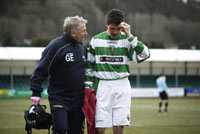Fifty Percent of Parents Don’t Understand Concussion Warning Signs
By Dan Peterson, TeamSnap's Sports Science Expert
So, as a parent of a young athlete, what would you do if your son or daughter came home from a game or practice with a headache, some dizziness or blurry vision? Would you rush off to the urgent care or ER to have them seen by a physician or would you wait until later or the next morning to see if the symptoms cleared up? These types of questions were asked of over 500 parents and coaches in a recent survey, with the results being reported at last month’s American Academy of Pediatrics (AAP) National Conference & Exhibition in Washington, DC. Researchers concluded that we need more education about the proper care needed for head injuries.
Specifically, the survey included parents, coaches who were also parents of kids aged 18 or younger and coaches who did not have any kids under 18. A surprising 50% of parents and over 40% of coaches would send an athlete with symptoms of a head injury back into a game before being examined by a doctor.
Since actual concussions are present in about half of these situations, these results show that injured athletes would be put back into competition about 20% of the time. While this doesn’t mean that we have lots of uncaring parents who ignore symptoms like dizziness, blurry vision or headaches, it does show that not all parents or coaches understand that those symptoms could indicate a concussion or traumatic brain injury.
"One group's typical response was to `take no chances' and seek immediate medical attention, while the second group was more likely to engage in 'watchful waiting' and delay seeking medical attention," said Edward J. Hass, PhD., director of research and outcomes at the Nemours Center for Children's Health Media, and the lead researcher of this study. "Our research leads us to believe the latter group was not adequately informed about the implications of key symptoms pointing to a possible concussion."
Plenty of media attention about head injuries, especially in the NFL, has raised awareness among parents and coaches about the dangers of contact sports.
"The study shows there are gaps that must be filled to ensure that all youth athletes have an advocate for the safety of their developing brains on the field of play," said Dr. Hass. "These results speak to me as a researcher, parent of a youth athlete, and youth coach."
At the same time, the many benefits of playing competitive sports shouldn’t be sacrificed out of fear of injury. Kids learn so much about teamwork, effort and goal-setting from sports that to eliminate the opportunities would seem extreme. Unfortunately, the survey found that one in four parents whose kids don’t currently play sports would keep them out based on these results.
"While that is certainly acting on the side of caution, it also keeps a child from experiencing the benefits of sports," said Dr. Hass. "We feel that with continued awareness-building on safe return-to-play protocols, sports participation can be enjoyed by all children in as safe a manner as possible."
Proper guidelines and plenty of educational materials on concussions can be found at the Heads Up website of the U.S. Centers for Disease Control.
NEW! Free Sports Organization Resources
All of TeamSnap's ebooks, articles, and stories in one place. Access Now
Similar Articles:

Recognize Sports Concussion Symptoms
By Dan Peterson, TeamSnap's Sports Science Expert …
Read More
Hockey Concussions Actually Thin The Brain’s Cortex
By Dan Peterson, TeamSnap's Sports Science Expert …
Read More
How to Recognize the Signs of a Concussion for Parents
Think you know concussions? Here’s a little quiz for…
Read More
